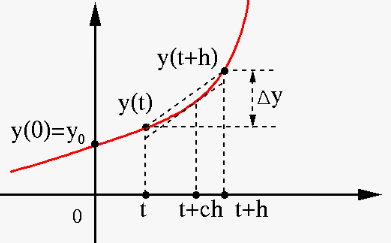Only in the special case of LCCODE, can the equation be solved
analytically to obtain a closed-form solution as discussed above.
In the general case of nonlinear ODE systems, the closed-form
solutions no longer exist, and we can only solve such an equation
numerically based on a given initial condition  .
.
We first consider solving a first order ODE which can be
written in the explicit form:
 |
(179) |
This ODE can be solved iteratively, by estimating its next
value  from the previous one
from the previous one  :
:
where  is the step size,
is the step size,
 ,
,
 is a value between 0 and
is a value between 0 and  , and
, and
 |
(181) |
is the slope of the secant of the function  through
the two
through
the two  and
and  , which, according to the
mean value theorem, is equal to the derivative of the
function at some point
, which, according to the
mean value theorem, is equal to the derivative of the
function at some point  inside the interval
inside the interval ![$[t,\;t+h]$](img476.svg) .
.

However, as the slope  of the secant is unknown,
all methods considered below approximate
of the secant is unknown,
all methods considered below approximate  from
from  based on certain estimated slope of the secant between
based on certain estimated slope of the secant between  and
and  :
:
 |
(182) |
The goal is to minimize the error, represented as a kth power
function of the step size  :
:
error |
(183) |
As  is small, the higher the order
is small, the higher the order  of the error term,
the more accurate a method is.
of the error term,
the more accurate a method is.
Eq. (180) can be expressed as an iteration:
 |
(184) |
where  ,
,
 ,
,
 ,
,
 , and
, and
 .
.
We further note that the increment
 in Eq. (180) can also be obtained as an
integration based on the given
in Eq. (180) can also be obtained as an
integration based on the given
 , by the
method of
Newton-Cotes quadrature:
, by the
method of
Newton-Cotes quadrature:
 |
(185) |
However, we note that in these equations, function values
such
 and
and  are
unknown and need to be estimated so that the error is minimized.
are
unknown and need to be estimated so that the error is minimized.


 from the previous one
from the previous one  :
:
 is the step size,
is the step size,
 ,
,
 is a value between 0 and
is a value between 0 and  , and
, and

 through
the two
through
the two  and
and  , which, according to the
mean value theorem, is equal to the derivative of the
function at some point
, which, according to the
mean value theorem, is equal to the derivative of the
function at some point  inside the interval
inside the interval ![$[t,\;t+h]$](img476.svg) .
.







 :
:

 is small, the higher the order
is small, the higher the order  of the error term,
the more accurate a method is.
of the error term,
the more accurate a method is.

 ,
,
 ,
,
 ,
,
 , and
, and
 .
.



 trapezoidal rule based on two points:
trapezoidal rule based on two points:
![$\displaystyle \int_t^{t+h} y'(\tau)\,d\tau\approx \frac{h}{2}[y'(t)+y'(t+h)]
=\frac{h}{2}[f(t,y(t))+f(t+h,y(t+h))]$](img491.svg)
 Simpson's rule based on three points:
Simpson's rule based on three points:


![$\displaystyle \frac{h}{6}[y'(t)+4 y'(t+h/2)+y'(t+h)]$](img495.svg)

![$\displaystyle \frac{h}{3}[f(t,y(t))+4 f(t+h/2,y(t+h/2))+f(t+h,y(t+h))]$](img496.svg)
 Simpson's 3/8 rule based on four points:
Simpson's 3/8 rule based on four points:


![$\displaystyle \frac{h}{8}[y'(t)+3y'(t+h/3)+3y'(t+2h/3)+y'(t+h)]$](img498.svg)

![$\displaystyle \frac{h}{8}[f(t,y(t))+3f(t+h/3,y(t+h/3))+3f(t+2h/3,y(t+2h/3))
+f(t+h,y(t+h))]$](img499.svg)
 and
and  are
unknown and need to be estimated so that the error is minimized.
are
unknown and need to be estimated so that the error is minimized.